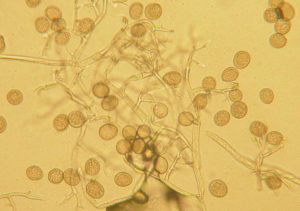Identifying Basil Downy Mildew Based on Symptoms
The diagnostic symptom of this disease is the dusty to fuzzy appearing growth of the pathogen on the lower surface of leaves. Typically it is dark brown. It can be a lighter almost gray color on some spice types of basil. This growth is the pathogens spores (sporangia) plus the structures the spores form on (sporangiophores). Sometimes it is on the upper surface. Morning is the best time to see this sporulation, following a night with dew or relative humidity near 100%, because under these conditions the pathogen produces spores. During the day spores are dispersed by wind. Sporangiophores that remain are not pigmented like the spores and thus are not readily visible.
Leaves affected by downy mildew usually are yellow. Yellow tissue often occurs in bands defined by major veins reflecting the fact the pathogen as it grows through leaf tissue cannot progress through large veins. Affected leaves can be yellow with no signs of sporulation when plants are not exposed to dark, humid conditions. To determine if the yellowing is due to downy mildew infection, sporulation can be encouraged by putting yellow leaves upside down on wet paper towel in a ziplock bag in dark overnight or putting potted plants in a closed plastic bag with wet paper towel overnight.
Photographs of symptoms at this web page were submitted by reporters to confirm downy mildew on their basil.
The following four photographs of characteristic symptoms on lower and upper leaf surfaces followed by images of the pathogen’s spores through a dissecting microscope and then a compound microscope were taken by Rebecca Melanson, Mississippi State University.




